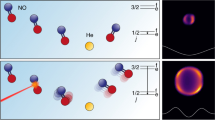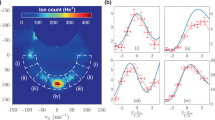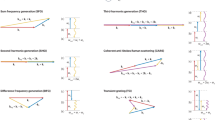Abstract
We disagree with the assertion of Grüninger et al. that the Raman peaks from LaMnO3, which we interpret as being due to scattering from orbital excitation, are caused by multiphonon excitation.
Similar content being viewed by others
Saitoh et al. reply
First, the estimated oscillator strength, f, of their observed 160-meV peak in the optical conductivity, σ(ω), is less than 1 × 10−6, which is much weaker than those of the main Mn–O stretching mode at 71 meV (f≈2 ×10−4) and of the electronic charge excitation at around 1.9 eV (f≈2.7 × 10−1; ref. 1). Such a weak infrared peak is explained by a spin-allowed d–d electronic excitation that becomes infrared-active through the disruption of local-inversion symmetry due to impurities and/or defects. The orbiton represents one such low-energy d–d excitation, although it can show k-dispersion.
Figure 1 shows the polarization dependence of the σ(ω) and Raman spectra for a detwinned LaMnO3 crystal at about 10 K. As the σ(ω) was deduced from the reflectivity, the weak intensity (around 1 ω−1 cm−1) of the infrared-active peak is barely detectable. The σ(ω) spectra are also plotted as functions of the doubled photon energy (Fig. 1, dashed lines). The infrared-active phonon at 80 meV is observed only in the E⊥z polarization ((x,x) configuration; Fig. 1, top). The E||z spectra do not show any peak at the corresponding energy, although the prominent Raman band at 160 meV is evident in the (z,z) configuration (Fig. 1, bottom).
Any combination of two infrared-active modes with the same symmetry may produce the Raman-active symmetry. However, it is hard to reconcile a two-phonon interpretation in terms of an 80-meV in-plane-active mode, with the strong Raman intensity observed in the (z,z) configuration. In addition, the peak energy of the Raman band in the (x,x) configuration deviates from the doubled energy of the 80-meV phonon peak with increasing temperature (Fig. 1, inset).
In LaMnO3, the 80-meV infrared-active mode in the E⊥z spectrum disappears above TJT≈750 K. In LaCoO3, the σ(ω) spectra deduced from the reflectivity data do not show any prominent peak near 82 meV (ref. 2), in contrast to the 80-meV mode in LaMnO3, which is weak but clearly discerned as the Jahn–Teller (JT) distortion-induced mode (f≈1 × 10−5). The origin of the 82-meV peak in LaCoO3 observed by Grüninger et al. is interesting, but irrelevant to the origin of the intense, high-frequency Raman modes observed for LaMnO3.
By considering both the electronic and phononic contributions to the orbiton energy equally, we have quantitatively estimated the parameter values of the interactions3. Using these values, we have calculated the Raman spectra that show good agreement with the experimental results. The large discrepancy between our and previous estimates, as pointed out by Grüninger et al., arises from the absence or averaged treatment of the strong electron correlation.
References
Tobe, K., Kimura, T., Okimoto, Y. & Tokura, Y. Phys. Rev. B 64, 184421 (2001).
Yamaguchi, S., Okimoto, Y. & Tokura, Y. Phys. Rev. B 55, R8666–R8669 (1997).
Okamoto, S., Ishihara, S. & Maekawa, S. Phys. Rev. B 65, 144403 (2002).
Author information
Authors and Affiliations
Corresponding author
Rights and permissions
About this article
Cite this article
Saitoh, E., Okamoto, S., Tobe, K. et al. Experimental quest for orbital waves. Nature 418, 40 (2002). https://doi.org/10.1038/418040a
Issue Date:
DOI: https://doi.org/10.1038/418040a
Comments
By submitting a comment you agree to abide by our Terms and Community Guidelines. If you find something abusive or that does not comply with our terms or guidelines please flag it as inappropriate.




